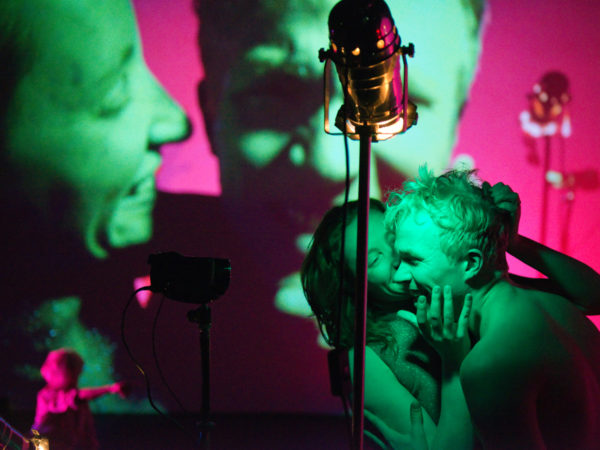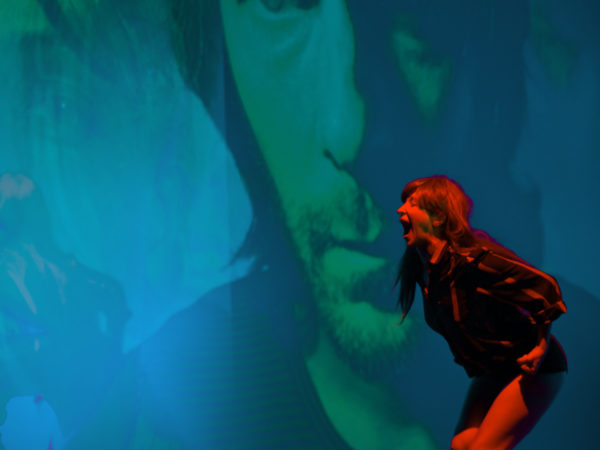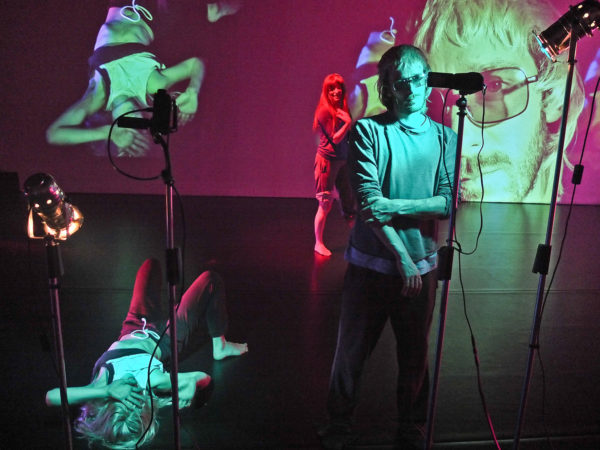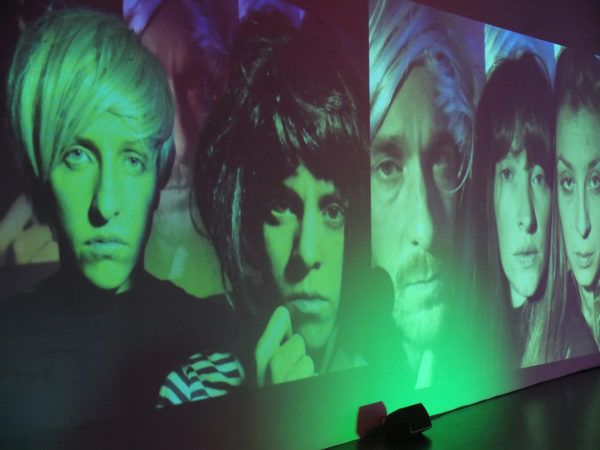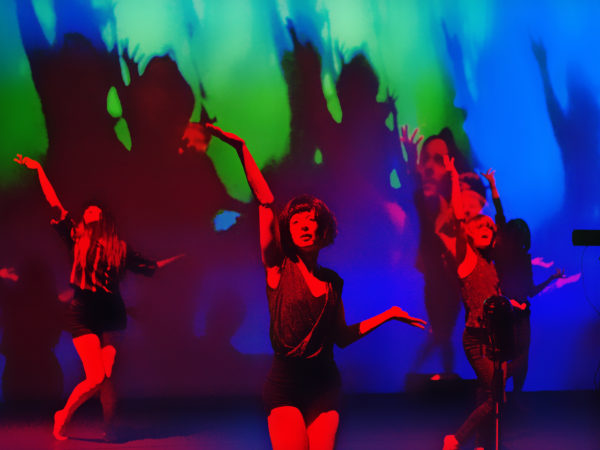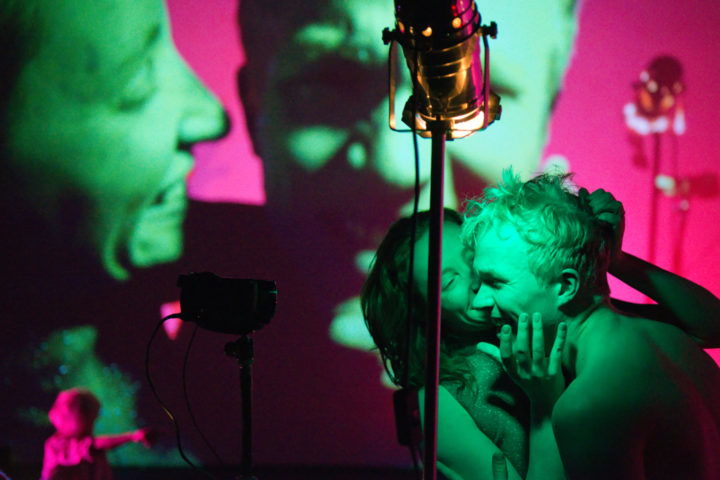
shiny, shiny…
The mirror has always been seen as a medium of both truthfulness and deceit. Moreover, if held up to someone, it is supposed to lead to self-awareness. Today with a few clicks on a smartphone one can reflect, transform, distribute, send and share their outwards appearance and inner feelings of self-worth.Celebrities, drag queens, models, critics, curators, art-collectors, or poets: they all laid their very selves bare in 3 minute close- ups. Behind the camera back then was Andy Warhol, shooting portraits of their most intimate moments.
Shiny, shiny… is the first part of the Imploding Portraits Inevitable series of performances, which confront the current media-guided self-optimization with its own history’s avatar. Post-processed wraiths from the Factory produce their own screen tests in a game of deceptions, a puzzle of glaring full-totals and extreme close-ups. Light and shadow appear to defend their bullheaded independence to the sound of a Velvet Underground feedback that’s coupled to the now, while far at back we hear faint voices of Chelsea Girls.
Warhol’s Exploding Plastic Inevitable has turned into an imploding anti-spectale.
photos: m. loizenbauer, ch. haring
shiny, shiny …
by christian höller
”Shiny boots of leather“ are something you’ll be looking for in vain in Liquid Loft’s latest piece, which kicks off the larger Imploding Portraits Inevitable cycle. This is not to say that Shiny shiny… doesn’t pick up a fair amount of bits and pieces from the surroundings of Andy Warhols Factory, their resident band The Velvet Underground and even Warhol’s historic multi-media spectacle The Exploding Plastic Inevitable – turning them into something indubitably contemporary, fundamentally rooted in the here and now. Shiny boots of leather, invoked in the imagination of all those who have the song Venus in Furs present – are just as absent as further too one-dimensional “props”, which could be employed to reconstruct an ominous past.
The actuality of Shiny, shiny… is of a completely different kind, not only informed by the here and now (that which the actors create in situ), but especially through the feedback loops that constantly split this present and, in a manner of speaking, multiply it. Split and union, individuation and superimposition are here as mechanisms, to be acted out on different levels. This does not only concern the self- staging subjects who, at the same time are externally set in scene or the iconic images and media-doubles, constantly produced in the process. The reversed process equally signifies the becoming-one, at first with oneself, and then with the group, the dropping out of the group of the involved subjects and ultimately their remaining in floating, undefined constellations. The split also marks the unique relationship to history that carries the piece: This does not exhaust itself in retro re-enactments of vanished pasts, not even evoking their moods in a pastiche like summoning. Shiny, shiny follows the alternative route based on the conscious application of the fracture. It puts contemporary modes of self-discovery and representation at the center, and allows things that are possibly gone (but which we never experienced first-hand) to linger on in a beguiling way.
but first things first:
What faces us (and itself) at first, are six performers, or rather their media-projections. Six actors, entwined in a game of continuous, constantly fractured yet stubbornly continued self-staging which perpetually yields split-products and surplus media. There are, to begin with, the characters that are created by the performers – immediately recognizable to the adept as enhanced revenants from Warhol’s factory. They, however, transcend these roles, as can be easily made out, by repeatedly reworking and rearranging their props (wigs, Sixties’ retro-clothing, etc.) gaining a distance from them. Left to their own devices by the larger than life father-figure of Warhol, they are required to produce their own “screen tests”. Operating with two mobile cameras and a number of spotlights they create extreme close-ups of themselves – which, combined with glamorously lighted long shots, generate their own video feedback – all born from its own technological nature, without any major external intervention.
At a next step these live-images are projected onto a partitioned screen behind the performers, which simultaneously creates an animated self-referential scenery made of the ongoing performances, that seemingly gets burst open by the feedback effects. Next to this video screen is a further projection, where silhouettes, shadow play and splashes of color live a life of intensive light. Just like, on a general level, the whole scenery is ruled over by a world of shadows and swathes of color, where the actors constantly interact not only with themselves, the group, their images (and the duplications – or multiplications in the feedback loop), but also with the shadows cast across the room. This gives rise to an extremely manifold figuration where real and virtual, the physical and the projected inevitably start to mix.
As far as the sound is concerned Shiny, shiny…is shaped by a use of material which, in the same manner, doesn’t allow things present and past, seen and heard to be in congruence. There are, on the one hand, the obviously fake soundtracks – the noise of breathing, for example, which one of the performers can be seen in acting almost synaesthetically in the camera close-up, or white noise coming in subtly at the very beginning, rising in level and enshrouding all of the stage-setting in a pulsating drone. On the other hand there’s the music, produced by Andreas Berger, playing its part in tying the whole setting together concisely. An impressive version of Velvet Underground’s Venus in Furs, shaped with contemporary sound-processing tools pushes itself to the front repeatedly and in a variety of versions. And in the shape of the instrumental track to The Gift, the sound goes beyond every song-based foundation, only to be brought back to the human, the dialogue-like through the distorted sing-song of “Mama, look at me now.”
“mama, look at me now”, …
… like the other fragments of dialogue that determine the sonic happening, has its source in one of various Warhol movies, more specifically the films made by Paul Morrissey: Flesh (1968), Trash (1970) and Heat (1972). For the most part it is verbal self-reflections or verbalized “posing” that characterizes the fragments of sentences uttered by Joe Dalessandro or Geri Miller. Frequently these dialogues linger like some Jive-Sound as faint echoes in the multi-media permeated room. This way it doesn’t matter whether you can place verbal cut-outs like “fornication”, “copulation” or the looped commonplace: “she’s gonna be a big star.” What matters is that, however broken – the connection between these snippets and the bodies in the here and now and their sometimes bizarre contortions, which tell about an (ultimately futile) attempt to incorporate them.
In all this Shiny, shiny… is not for the least part also about incorporating the hip formulas, the Sound from back in the day into a contemporary bodily reality without pining for a bygone era or drowning in nostalgia.
The noble approach of self-affixation the actors base the reflections of their identities on repeatedly drifts into an overtly symbolic need to scratch themselves. Something itches – maybe because the costumes don’t fit, or the amphetamine comedown sets in or maybe because something is fundamentally wrong with these self-images – because all the produced pictures are no longer able to capture this self? None of this can be said with certainty. But in a consciously ambiguous way the self-imposed compulsion to permanently produce ego-images or to practice media-guided self-optimization gets exposed.
What remains are layers of feedback loops towering above each other, accompanied by blinding light and semi-melancholic swathes of colors – “different colors made of tears…
translation: o. stummer
CODA Oslo International Dance Festival, NO
Tanzquartier Wien, AT
Via 2016, Maubeuge, FR
Tanzhaus NRW, Düsseldorf, DE
Tanzhaus NRW, Düsseldorf, DE
Incubate Festival Tilburg, NL
Incubate Festival Tilburg, NL
Incubate Festival Tilburg, NL
Tanzquartier Wien, AT
Tanzquartier Wien, AT
Tanzquartier Wien, AT
dates
Dance, Choreography: Luke Baio, Stephanie Cumming, Katharina Meves, Anna Maria Nowak, Arttu Palmio, Karin Pauer
Artistic Direction, Choreography: Chris Haring
Composition, Sound: Andreas Berger
Light Design, Scenography: Thomas Jelinek
Costume: Julia Cepp
Theory, Text: Stefan Grissemann
Video Live on Stage: by the performers
Stage Management: Roman Harrer
Light Design Assistance: Sveta Schwin
Documentation & Photos: Michael Loizenbauer
Distribution: Line Rousseau & Marion Gauvent, A PROPIC
Production Management: Marlies Pucher
A co-production of Tanzquartier Wien & Liquid Loft
Duration: 65min.
Liquid Loft is supported by: MA7 Kulturabteilung der Stadt Wien (Cultural Department of the City of Vienna) and BKA Bundeskanzleramt Kunst & Kultur (Austrian Federal Chancellery Arts & Culture)
credits
wiener zeitung, 23.1.2015
Warhols Erben / Verena Franke
“Am Puls der Zeit” zu sein klingt nach einer abgedroschenen Phrase. Ist es auch. Dennoch, die Redensart fasst Chris Harings Schaffen punktgenau zusammen. Auch sein am Donnerstag uraufgeführtes “Shiny, Shiny . . . Imploding Portraits Inevitable” reiht sich in diese Beschreibung ein.
Der österreichische Performer widmete sich zuvor etwa in “Deep Dish”, einem Teil der “Perfect Garden”-Serie, allen Facetten der Nahrungsaufnahme, davor behandelte er in “Talking Head” das Thema Soziale Medien. In seiner neuen Serie “Imploding Portraits Inevitable” geht es nun um die Selbstdarstellung via Smartphone, das Posieren vor der Handykamera, die narzisstische Selbstbeweihräucherung von üppigen oder gar nicht so üppigen Körperpartien. Diese Thematik verbindet Haring mit Andy Warhols “Exploding Plastic Inevitable” – von Anfang 1966 bis Mitte 1967 veranstaltete der Pop-Art-Künstler eine Serie von multimedialen Performances und Happenings, die in Zusammenarbeit mit der Rockgruppe The Velvet Underground und der Sängerin Nico in The factory, seinen Studios in New York, stattfanden. Und so katapultiert Haring sein Publikum im Tanzquartier Wien mit einem Schlag in die 60er – und bleibt dennoch gegenwärtig. Inklusive Rausch. Drogen sollen es damals gewesen sein, heute gelingt eine fast psychedelische Wirkung mit farbintensiven Bildern und einem Sound, für den einmal mehr Andreas Berger verantwortlich ist: Mit zwei Videokameras und Scheinwerfern werden live Gesichter als eindringliche Porträts in einem extremen Close-up auf die Leinwand gespielt – mal simpel, dann wieder kaleidoskopartig. Es scheint, als würden diese Gesichter der Performer mit ihren fesselnden und durchdringenden Blicken einem direkt in die Seele schauen können. Besonders fasziniert hier Arttu Palmio gleich zu Beginn, Stephanie Cumming, jahrelanges Mitglied von Harings Liquid Loft, zeigt auch hier ihr schauspielerisches und performatives Talent.
Voguing für Selfies
Selbstinszenierung lautet die Devise der sechs Performer, ihre Perücken tauschen sie ständig, sie erfinden sich immerfort neu. Dies geht einher mit repetitiven Bewegungssequenzen, die an Voguing erinnern – einen Tanzstil, der in den 60er Jahren in New York erfunden wurde. Zackige Arm- und Beinbewegungen gemahnen an das Posing dieser Tanzart – wie eben auch das Posen für Selfies.
Doch dann kommt es zum Bruch: aus dem Original “Exploding” wird Harings “Imploding”. Die Tonspur und Bewegungen werden schneller, die Szenerie wird skurriler und künstlicher. Haring überzeichnet und kritisiert den heutigen Selbstkult mit Mitteln der Vergangenheit, allen voran mit Warhols ähnlichen Bildspektakeln und auch mit Zitaten aus Filmen der Morrissey/Dallesandro-Trilogie, die in The factory entstanden sind. Verpackt hat er dies in eine Party-ähnliche Inszenierung, die fesselt, schmunzeln lässt und letztlich auch einen Spiegel vorhält.
der standard, 23.1.2015
Selfiegespenster aus der Warhol-Factory / Helmut Ploebst
Wie in Trance irren Gespenster durch flackernde Bilderverliese. Ihre Benommenheit hat Marshall McLuhan als jene beschrieben, die dem Narziss widerfuhr, als er süchtig nach seinem Spiegelbild wurde: Narkissos, der griechische Name der mythischen Figur, und die Narkose, so der Medienphilosoph, seien nicht ohne Grund wortverwandt.
Der österreichische Choreograf Chris Haring ist für sein neues Stück Shiny, shiny … – Imploding Portraits Inevitable, das gerade im Tanzquartier Wien gezeigt wird, mit den Tänzerinnen und Tänzern seiner Gruppe Liquid Loft in die Gewölbe der 1960er-Jahre hinuntergestiegen. Konkret in Andy Warhols New Yorker Factory, dieses großartige Psychokabinett mit dem Nimbus des Legendären.
Aus Warhols “Exploding Plastic Inevitable”-Eventserie von 1966/67 ist bei Haring eine Implosion des Porträts geworden. Der Haupttitel des Stücks stammt aus den Lyrics von Venus in Furs der Factory-Band The Velvet Underground. Das Motiv der Porträts bezieht sich auf Warhols berühmte “Screen Tests”-Filme und – unter anderem – auf Chris Harings frühere Arbeit Talking Head, in der er sich über den Narzissmus in den sozialen Medien lustig macht.
Was der luzide McLuhan, ein wenig geblendet von seinem Sixties-Optimismus, noch nicht vorausgeahnt hat, wird heute – auch bei Shiny, shiny … – immer deutlicher sichtbar: wie das Spiegelbild des Narkissos das Regiment übernommen hat, dem sich Millionen narkotisierter Mediensubjekte freudig unterwerfen. So werden, in geistiger Unschuld, Untote als Abbilder ihrer eigenen Selfies produziert.
Dabei hat sich die gute alte Frage “Wer bin ich?” abgewandelt in: “Wie wirkt mein Bild?” Genau das führt Shiny, shiny … vor. Im Bilderfluss der Performance spülen zwei Kameras, zwei Projektoren, eine Soundanlage und ein paar Scheinwerfer die sechs Figuren auf der Bühne in sich und scheiden sie wieder aus: Ihre Gesichter, ihre Körper, ihr Verhalten werden virtuos verschattet, zerleuchtet und durchmischt. Damit ist dem Liquid-Loft-Trio Chris Haring, Andreas Berger und Thomas Jelinek wieder ein außerordentliches Tanzstück gelungen.
tanz.at, 24.1.2014
Chris Haring hat seine „Perfect Garden“-Serie abgeschlossen und mit „Imploding Portraits Inevitable“ eine neue Performance-Reihe begonnen. / Ditta Rudle
„Shiny, shiny …“, der Beginn, erzählt von der heute zwanghaften Selbstreproduktion, die per Smartphone in alle Welt geschickt wird und setzt diese Sucht nach Außenwirkung und Selbstdarstellung in Verbindung mit dem 1960er Jahre Star Andy Warhol und seinen „Screen Tests“-Filmen.
Reverenz und Referenzen. Der Titel der Eröffnungsperformance ist der Beginn des Songs „Venus in Furs“ der Rockband „Velvet Underground“, mit der Pop-Artist Andy Warhol Mitte der 1960er Jahre zusammen gearbeitet hat. Auch der Serien Titel – „Imploding Portraits Inevitable“ – referiert auf Warhol, der mit Velvet Underground Multimedia-Happenings – „Exploding Plastics Inevitable“ – inszenierte.
Schatten und Doppelbilder.
Der gesamte Soundtrack von Andreas Berger (Rauschen, Dröhnen, Knistern, Kratzen und Keuchen, Bearbeitungen von „Venus in Furs“, Fetzen von Zitaten aus Warhol-Filmen) beruht auf Vergangenem oder ist extrem künstlich, unwirklich, gespenstisch; Julia Cepp hat die Kostümierung der sechs PerformerInnen – Hotpants im Glitzerlook, Stiefel, Perücken – im Stil der 1960er geschaffen; auf der zweigeteilten Videowand erscheinen die Live-Bilder der Agierenden, mit zwei beweglichen Kameras schaffen Closeups ihrer Gesichter, Totalaufnahmen leuchten in poppigen Farben, verdoppeln, verdreifachen sich, werden ins Unendliche vervielfältigt. Auf einer zweiten Projektionswand tanzen die Silhouetten der PerformerInnen, wirken die Farbspiele als den Geist verwirrende Psychedelika, geistern Schatten durch die künstliche Welt. Wer tanzt mit wem? Die Wirklichkeit mit der Vergangenheit? Und wer führt? Die Schatten? Die eigenmächtig sich generierenden Videofeedbacks? Oder doch die TänzerInnen im Dämmerlicht der Bühne?. Sicher ist nur: Warhol steht nicht mehr zur Verfügung hinter der Kamera, die Darstellerin müssen ihre „Screen Tests“ selbst erzeugen.
Längst bin ich im Irrgarten der Bilder verloren gegangen. Wo, wer sind die lebendigen, die echten Menschen, was ist nur ihr Abbild, das mich narrt mit dem Abbild des Abbildes, in nicht endender Reihe. Bin ich noch ich oder auch bereits ein Schatten.
Screen Test wird zu Selfie.
Das Publikum wird durch Zitate und Referenzen um 50 Jahre zurückgeworfen und , in eine Zeit, in der die Mehrheit noch gar nicht auf der Welt war. Was weiß dieses Publikum von Warhol und seiner Factory? Wie auch immer, auch wenn es die 15-Minuten-Stars, die sich immer wieder affenartig kratzen, juckt, es geht nicht um das Gestern, das dient nur als Transportmittel, wir sind im Heute. Nicht Screen Test sondern Selfie ist angesagt.
Auch die Mittel sind heutig: Mit der perfekt eingesetzten Technik (Lichtdesign und Szenografie: Thomas Jelinek, Technik Video: Michael Loizenbauer) kann man auch ein Publikum bei Laune halten, für das die nur noch auf dem Kunstmarkt lebendigen Kultfigur nichtmehr als ein Mythos ist. Die Tänzer (Luke Baio, Arttu Palmio und Tänzerinnen Stephanie Cumming auch choreografische Assistentin, Katharina Meves, Anna Maria Nowak und Karin Pauer) agieren solipsistisch oder synchron, rücken ihr Outfit zurecht und sorgen sich um ihr Videofeedback. Warhols serielle Kunst grüßt von der Videowand.
Melancholie und Konfusion.
Die optimierte Vergangenheit, so ganz gegenwärtig, macht mir mehr Angst als sie unterhält, obwohl die Bewunderung für die technische Brillanz des gesamten Environments wie der TänzerInnen sich auch ihren Platz sucht. Eindrucksvoll ist diese Performance in jedem Fall. Chris Haring ist immer auf der Höhe der Zeit, sein Blick auf die Gesellschaft und ihr Verhalten hat die Schärfe eines Röntgenstrahl und er zeigt, was er sieht. Ohne ein Urteil abzugeben, mit den Mitteln (und Mitarbeitern) die er perfekt nützt. Es muss an der Beschleunigung, die uns alle voran treibt, liegen, dass die Darbietung von Serie zu Serie (Posing Project, Perfect Garden) diffuser, unwirklicher, verwirrender wird. Am Ende löst sich alles auf, die Musik verhallt, die Schatten verblassen, die Farben ergrauen, die TänzerInnen verschwinden. Was bleibt ist Melancholie und Konfusion.
profil, foto der woche, 19.1.2015
1129_Profil_8868865_150118.pdf (888.70 KB)
reviews
“Meanwhile the long-standing question “Who am I?” has become transformed to “What is the effect of my picture?” Which is exactly what Shiny, shiny… acts out. The stream of images, made up of two cameras, two projectors, a sound system and a couple of spots washes away the six figures on stage only to emit them again: Their faces, their bodies, their behaviour all shaded, drowned in light and blended in sheer virtuosity. In this the trio Liquid Loft, Chris Haring, Andreas Berger and Thomas Jelinek, once again managed to create an exceptional piece of dance.”
Der Standard / Helmut Ploebst
“Haring caricatures and criticizes the contemporary cult of the self with means from the past. Most of all with Warhol’s similar image-spectacles including quotes from movies from the Morrissey/Dallesandro-Trilogy which also were created at the factory. All this he presents in a party-esque production that enthralls, makes you smile and ultimately holds up a mirror.”
Wiener Zeitung / Verena Franke
“Chris Harings is constantly on the leading edge, his view for society and its behavior appears to possess x-ray precision and he presents what he observes.”
tanz.at / Ditta Rudle

